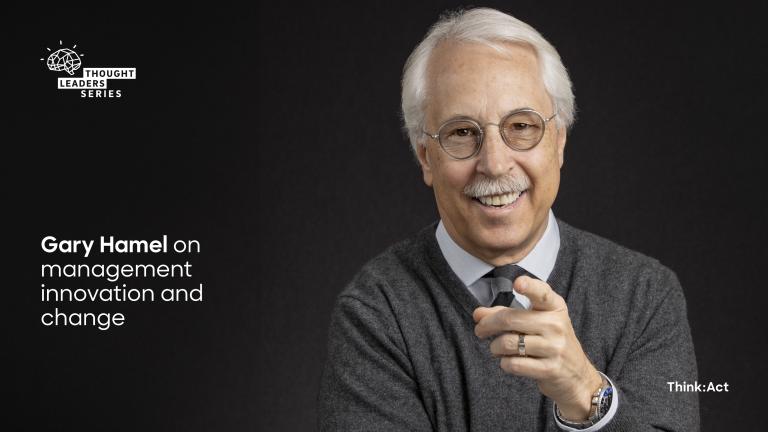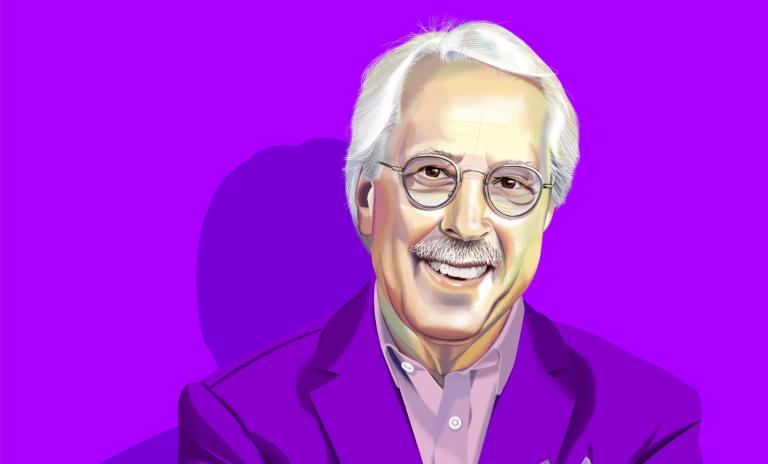It's time to rethink AI
![{[downloads[language].preview]}](https://www.rolandberger.com/publications/publication_image/ta42_en_cover_download_preview.jpg)
As our lives and work are increasingly being reshaped by AI, the new edition of Think:Act Magazine explores what this means for C-level managers.


by Neelima Mahajan
Illustrations by Nigel Buchanan
Renowned strategist and management innovator Gary Hamel thinks business leaders should lean into our age of upheaval. That means breaking free of bureaucracy and empowering organizations to be as nimble as change itself.
Why do you think change is so hard for organizations?
Deep change almost always happens in a crisis. The pathologies and the disabilities that you see in organizations have deep roots. If we're going to build fundamentally more capable institutions, we have to change the very DNA of our companies. In the early development of industrial bureaucracy, they were trying to solve a very specific problem: efficiency at scale and maximizing compliance. You had to take all these handmaids, farmers, craftspeople, etc. into factories and they had to show up on time and be as reliable as the machines around them. Unfortunately, that's not really an advantage that pays off today. You still need compliance and predictability in certain areas, but it is no longer a differentiating advantage in most industries.

Bureaucracy was a product of its time. If you go back to the late 19th century, the average employee was illiterate and information was expensive to move. The hierarchy is largely just a way of consolidating information. In a hierarchy, only the person at the top has the full picture. Today, anybody can have the whole picture. One hundred and twenty years ago, management was a rare skill so we created business schools to train this new role called manager. But management as a skill set is no longer differentiating.
Just trying to change practices and processes is not going to be enough. You reach a point where you can't get a nonlinear gain in performance without going back to the first principles and paradigmatic beliefs. A lot of this is like putting a tutu on a dog: It doesn't make it a ballerina.
Gary Hamel has been at the London Business School for 30 years and is the director of the school's Management Lab. With C.K. Prahalad he was the initiator of groundbreaking concepts such as "strategic intent" and "core competence." His most recent bestsellers, Humanocracy and What Matters Now, offer new paths to align management with the future of business.
What do you think about the levers that govern competitive strategy today? Have the criteria and competencies that make an organization stand out on the market changed over the years?
As you look at change, the challenge is always to ask: What are the pivots; what are the deeper things that don't change; what are the changes that are trivial and are passing; and then, what are the changes that are very significant? Most of what C.K. Prahalad and I wrote about these are still very important, the idea of core competence.
Apple understands core competence: It's taken its capacity, design and software-hardware integration and it's just used it in product category after product category. It's also built new competencies. Over the last 12 years, they've built an internal capacity for chip design that is probably now the best in the world. Look at the commitment Tesla made to understanding battery technology and autonomous driving. These are very complex skills and the rest of the global auto industry is now struggling to catch up with all of this.
"Just trying to change practices and processes is not enough. This is like putting a tutu on a dog: It doesn't make it a ballerina."
The things that we argued about many years ago that drive competitiveness and aspiration are all still true: deep and world-class capabilities, resilience, the capacity to reinvent and reimagine the company if circumstances change. The expectations of the people coming to work have changed.
If you are my age, whether it was business, government, education or religion, it all looked like a hierarchy. Now, you have the generation that's grown up on the web and they think of social relationships as a network. If you have followers online, it is because people chose to follow you, not because you could order them to follow you. You put out an idea and let the crowd decide whether it makes sense or not. That is a fundamental, irreversible shift. But if you've grown up and you've been shaped by those realities, you will never change as a person.
So, if I grow up with that belief that you're a leader only if people are willing to follow you, and now my boss is using the big stick of hierarchy, you've just lost me. For many large companies, if they want to attract the best talent in the world, they're going to have to rethink how they lead and manage because the old model is simply going to drive the best people away.

The other thing that's changed is the velocity and the complexity of the environment. A business like TikTok can win a billion customers in 12-24 months. That's never happened before in human history. Think about the amount of VC investment going on around the world and the number of people who are trying to rethink health care and financial services has never been higher. One of the most important questions for the institution is: Are we changing as fast as the world around us?
All strategies have a life cycle, yet many organizations wait until they're on life support before contemplating change. But just because your strategy looks like it has a pulse doesn't mean it's not already dead. Be proactive and check if it may have reached its expiration date.
That bar is going up all the time. How do you attract the best talent in the world, given their expectations have changed dramatically? How will you build an organization that changes as fast as the world around it when that is accelerating? That problem is not one that's going to go away – and those things require radical solutions. No amount of tweaking at the margins in organizations is going to solve that.
You once said you don't see leaders today as the authors of strategy but rather as the editors of strategy. Why? Do you see an ideas deficit or a lack of ambition here?
Both. There's certainly an ideas deficit. The quality of any strategy is going to be largely dependent on the number of options and alternatives you generate in the first place.
If I take Silicon Valley as a metaphor for every company that's a success, you have hundreds that fail. If I want to find a game-changing idea, I have to generate a lot of options; you have to kiss a lot of frogs to find your prince or princess. Unfortunately, the traditional planning process is not very generative: It does not create a lot of new and interesting unconventional ideas. That's why whenever I do a strategy project in a company, it's completely open. We ask every single employee. We teach them how to think like innovators: How do you spot emerging trends; how do you think about your company's core competencies; how do you get at the unarticulated needs of customers, the deep anxieties, fears and needs? And out of that, what opportunities do we have? So, in a company of any size, I would want to create 2,000-3,000 strategic options.

And this is where the editor part comes in. Then, you look across those and you start to find the patterns: "If we go that way, it makes us more of a services company" or "this would take us in another direction." When you do it that way, you still have to build a strategy out of real insights. And once you can see a few hundred ideas that all cluster closely together, you are going to be very confident. We did this a few years ago with Adidas in North America: One of the things that suddenly emerged was that they never took women seriously as a consumer group. Their strategy was "shrink it and pink it," which meant make it smaller and change the color. When you have an industry run by men, unfortunately, these things happen. If you create a strategy using only the imagination at the top, you'll miss every substantial opportunity.
How do you think the nature of strategy life cycles has changed?
You need a strategy that's robust enough to survive and make sense under quite a few different contexts. What's most important now is that you have that three-to-five-to-10-year view like Tesla, and then you have huge velocity, a lot of resilience over the next few months, and the ability to pivot and move quickly. So strategies need to be a little broader and more robust. Maybe you still need specifics, but the specifics are going to be for the next 12 months, not for what you're doing three years out. I believe those are the two critical time frames.
Technological innovation is accelerating. Has management innovation kept pace?
No. If you look back through history, organizational innovation always lags behind technology innovation because organizations are embedded in human systems and in power structures, and they're very difficult to change. Our organizations are probably 50 years behind where our technology is. The ATLAS detector at the Large Hadron Collider at CERN had 6,000 engineers and scientists that worked together. Almost none of them are co-located. They had an incredibly organized community. On the paper that announced their findings, there were 6,000 names. That kind of collaboration 20 years ago was just impossible. The most recent Linux version has more than 25 million lines of code and was created by 15,000 contributors. Technology is making possible organizations that are far more horizontal and way less vertical. But if you look at how large companies are using technology, they're using Slack and Microsoft Teams to try and raise the productivity of white-collar work or teams. How many organizations are using open innovation platforms to create a strategy? Almost none.

![{[downloads[language].preview]}](https://www.rolandberger.com/publications/publication_image/ta42_en_cover_download_preview.jpg)
As our lives and work are increasingly being reshaped by AI, the new edition of Think:Act Magazine explores what this means for C-level managers.
